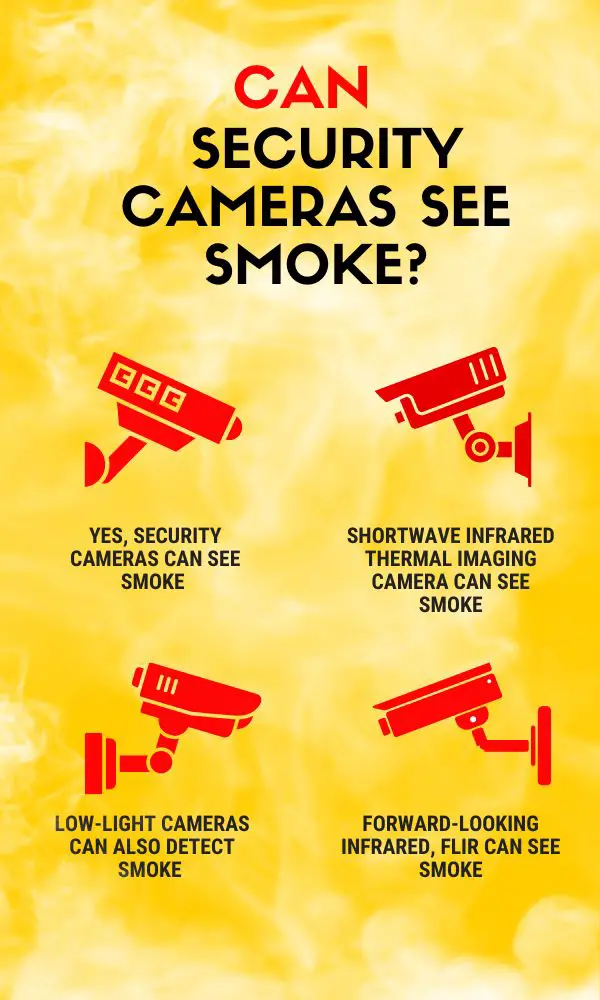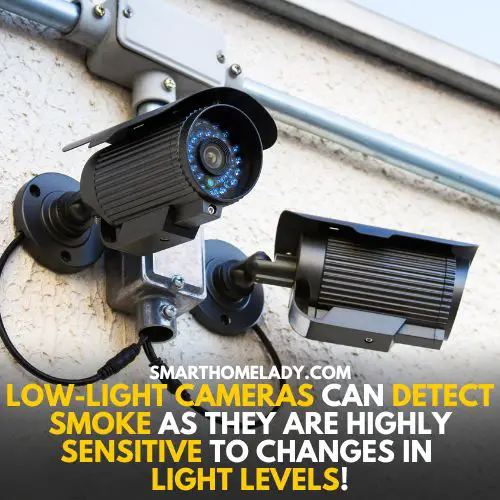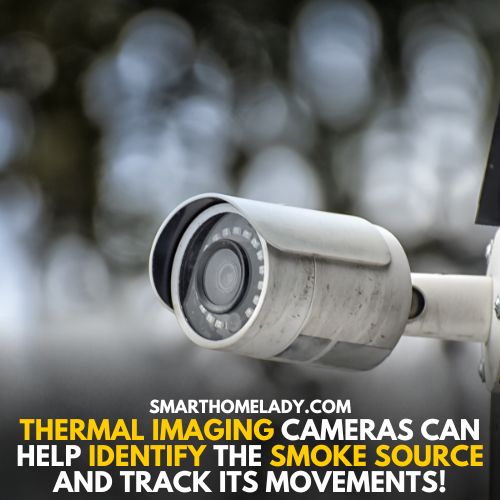Are you wondering if security cameras can detect smoke? It’s a common question among those looking to install surveillance systems in their homes or businesses. After all, having the ability to see through smoke could be crucial during an emergency.
The good news is that cameras and sensors are available that can pick up smoke and other forms of heat signatures.
In this blog post, we’ll explore the different types of cameras and sensors with this capability and how they work. So let’s dive in.

Contents
- 1 Do Cameras Pick Up Smoke? The answer is Yes!
- 2 What Cameras Can See Smoke? 3 Common Types
- 3 Can Night Vision See Through Smoke? IR Technology Makes It Possible
- 4 Can Thermal Cameras See through Smoke?
- 5 What Are The Benefits Of Using Security Cameras To Detect Smoke?
- 6 What Sensors See Through Smoke? SWIR Sensors To See Smoke
- 7 How To Tell If There Is A Hidden Camera In A Smoke Detector?
- 8 Flame Detector Camera
- 9 Can cameras see smoke at night?
- 10 Can smoke damage a camera?
- 11 Can School Cameras See Smoke?
- 12 Can smoke be seen in the dark?
- 13 Do all cameras have the ability to detect smoke?
- 14 Conclusion
Do Cameras Pick Up Smoke? The answer is Yes!
Yes, security cameras can see smoke. Visual-spectrum imagery and Infrared sensitive detection system in some cameras detect the smoke.
Security cameras are an essential tool for surveillance and crime prevention. They capture footage of events that may not be visible to the naked eye, providing valuable evidence in case of a break-in or other criminal activity.
But can security cameras see smoke? The answer is yes, they definitely can.
Cameras equipped with shortwave infrared thermal imaging technology can detect heat signatures even through thick smoke. This type of camera detects the radiation emitted by objects based on their temperature, making it possible to see through dense fog or smoke clouds.
Similarly, low-light cameras have enhanced sensitivity and can detect light levels as low as 0.1 lux or lower, allowing them to pick up faint traces of smoke in dimly lit areas.
However, it’s important to note that not all types of cameras have this capability. Standard CCTV cameras without specialized features won’t pick up on subtle changes in lighting caused by smoke particles.
If you’re looking for a camera system to detect potential fire hazards or alert you to any suspicious activity obscured by smoke, consider investing in advanced technologies like shortwave infrared thermal imaging or low-light capabilities.
With the right equipment installed properly and strategically placed around your property, you’ll have peace of mind knowing your assets are secure against harm from fires and intruders alike.
What Cameras Can See Smoke? 3 Common Types
When it comes to detecting smoke with security cameras, a few specific types of cameras are capable of doing so.
1. Shortwave Infrared Thermal Imaging Cameras
One such camera is the shortwave infrared thermal imaging camera. This type of camera works by detecting the heat signatures emitted by objects and can therefore detect even very small amounts of smoke.
2. FLIR System
Another type of camera useful in this regard is the FLIR system. FLIR stands for forward-looking infrared, and these systems work similarly to shortwave infrared cameras but typically offer higher resolution and more advanced image processing capabilities.
3. Low-Light Cameras
Low-light cameras can also detect smoke as they are highly sensitive to changes in light levels. However, these cameras may not be as effective as thermal or FLIR systems depending on the lighting conditions present at the time.

While several different types of cameras can potentially detect smoke, it’s important to choose one that is best suited for your specific situation based on factors like lighting conditions and budget constraints.
Can Night Vision See Through Smoke? IR Technology Makes It Possible
Yes, night vision can see through smoke. Night vision cameras use infrared technology to capture images in low-light conditions.
While they effectively capture clear footage in the dark, their ability to see through smoke depends on the type of smoke and its thickness.
Smoke particles can scatter light, making it difficult for any camera to capture clear images.
However, night vision cameras with thermal imaging capabilities may detect heat signatures beyond the visible range of light, which could penetrate thin layers of smoke.
The effectiveness of night vision cameras in detecting smoke also depends on other factors, such as humidity levels and air currents, that affect how much the camera can see through the haze.
In some cases, a fog or mist filter can help improve visibility by reducing glare from bright objects like street lights.
While night vision cameras may not always provide a perfect view through heavy amounts of smoke or foggy conditions, they are still useful tools for surveillance during nighttime hours when natural lighting is limited.
Read More: What Causes Video Loss In Security Cameras? 5 Causes & Fixes
Can Thermal Cameras See through Smoke?
Yes, thermal cameras can see through smoke.
However, the amount of detail that can be captured depends on a number of factors, including the thickness of the smoke and the camera’s sensitivity.
Some thermal cameras are also equipped with night vision capabilities, making them more useful when smoke limits visibility.
What Are The Benefits Of Using Security Cameras To Detect Smoke?
Security cameras can be useful in detecting potential fire hazards or suspicious activity obscured by smoke.
With the right equipment installed properly and strategically placed around your property, you’ll
- Have peace of mind knowing your assets are secure against harm from fires and intruders alike.
- In addition, thermal imaging cameras can help identify the smoke source and track its movements. This information can help determine the extent of damage and respond to the fire accordingly.

What Sensors See Through Smoke? SWIR Sensors To See Smoke
SWIR sensors, or shortwave infrared sensors, are used to detect and capture images of smoke at a wavelength that is invisible to the naked eye.
These sensors can see through smoke by detecting light in the 0.9-2.5-micron range of the electromagnetic spectrum.
SWIR sensors capture reflected light from objects emitting heat, such as flames or hot surfaces behind a layer of smoke. The sensor then creates an image based on the differences in temperature between these objects and their surroundings.
Advantages Of SWIR Sensors
- One advantage of SWIR sensors over other types of cameras is that they can operate in low-light environments without needing additional illumination sources. This makes them ideal for use in situations where visibility may be limited due to poor lighting conditions.
- Another benefit of using SWIR technology is its ability to penetrate certain materials like glass and plastic, which can obstruct visible light but not infrared radiation.
SWIR sensors offer a powerful tool for security monitoring applications because they allow users to see through obstacles like smoke while also providing clarity and detail, even under low-light conditions.
Read More
- Lights On Security Cameras And Their Meaning
- What Is Sleep Delay On Security Cameras?
- Why Do Security Cameras Have Bad Quality?
- Do Security Cameras Record All The Time?
How To Tell If There Is A Hidden Camera In A Smoke Detector?
It’s no secret that hidden cameras are becoming more and more common in our society. One popular location for these devices is inside smoke detectors, where they can capture footage without drawing attention to themselves.
So, how can you tell if your smoke detector has a hidden camera?
Firstly, it’s important to note that not all smoke detectors have cameras installed within them. However, if you’re suspicious of a particular detector or want to be sure there aren’t any hidden devices present, you can inspect the device itself.
The following are some ways to spot hidden cameras in a smoke detector.
- One way to spot a camera lens is by looking closely at the front face of the detector. If there is a tiny dot on the surface that appears black or darker than the surrounding area, this could indicate that there is a camera lens located behind it.
- It’s also worth noting that some modern smoke detectors may have small lights or other indicators built into them, which serve as notifications for things like low batteries or system malfunctions. These features should not be mistaken for camera lenses.
If you do find evidence of a hidden camera within your smoke detector or anywhere else in your home or workplace, it’s important to report it immediately to relevant authorities and take steps towards preventing further surveillance attempts from taking place.
Flame Detector Camera
A flame detector camera is a security device that can detect flames and alert authorities to potential fires. These cameras use advanced technology, including infrared sensors, to quickly detect the presence of flames.
Unlike traditional smoke detectors or fire alarms designed to activate when they sense smoke or heat, flame detector cameras can identify actual flames. This can be especially helpful in situations where smoke may not be present, but a fire has still started.
Flame detector cameras analyze the light emitted by flames and use this information to determine if a fire is present.

Some models also have built-in algorithms that can differentiate between different types of fires, such as those caused by gasoline versus those caused by wood.
Flame detector cameras are an important tool for any business or homeowner looking to improve their overall safety and security measures.
By providing early detection and warning of potential fires, these devices can help save lives and prevent costly damage from occurring.
Read More On
- Why Do Security Cameras Lag?
- Why Is My Security Camera Blurry?
- What Causes Ghost Images On Security Cameras?
Frequently Asked Questions FAQs
Can cameras see smoke at night?
Yes, cameras can see smoke at night. In fact, thermal imaging cameras are particularly effective at detecting smoke and other sources of heat.
These cameras are designed to detect differences in temperature, and since smoke is usually hotter than the surrounding air, it can be easily detected by a thermal camera.
Additionally, many security cameras are equipped with infrared technology, which can also detect smoke in low-light conditions.
Can smoke damage a camera?
Yes, smoke can damage a camera as it may cause the lens to become dirty and decrease the quality of the images. Smoke may also find its way into the camera and damage the internal components.
It is important to keep cameras away from smoke areas to avoid damage.
Can School Cameras See Smoke?
Yes, school cameras can see smoke as they are equipped with sensors that can detect changes in the environment.
Smoke can trigger the sensors, which then notify the security personnel of a possible fire. This is important in ensuring the safety of the students and staff in case of emergencies.
Can smoke be seen in the dark?
Yes, smoke can be seen in the dark as it reflects light. Although it may appear darker compared to smoke in the light, it can still be visible, especially if it is thick and dense.
For example, the smoke can still be seen during a fire even if the surroundings are dark.
Do all cameras have the ability to detect smoke?
No, not all cameras have the ability to detect smoke. While many security cameras are equipped with infrared technology or specialized sensors that can detect smoke, not all cameras are designed for this purpose.
It’s important to choose a camera that is specifically designed for smoke detection if this is a priority for your security needs.
Conclusion
Security cameras have become an essential tool for monitoring and safeguarding our homes. As I’ve discussed in this article, security cameras can see smoke, but not all types of cameras are equipped to do so.
Shortwave infrared thermal imaging cameras, FLIR systems, low-light cameras, and SWIR sensors all have the capability to detect smoke or objects through them.
It’s important to note that while security cameras can pick up on smoke, they are not a substitute for fire alarms or detectors. Fire alarms provide early warning signals when there is even a hint of danger so you can evacuate the premises immediately.
If used correctly alongside other fire safety measures, including fire extinguishers and sprinklers- security cameras are a valuable asset when it comes to identifying fires at the earliest possible stage.


